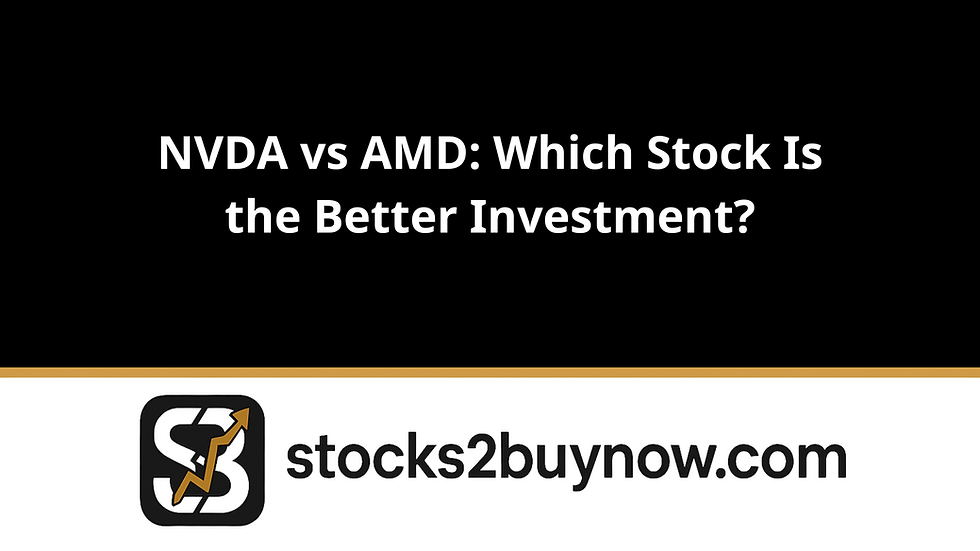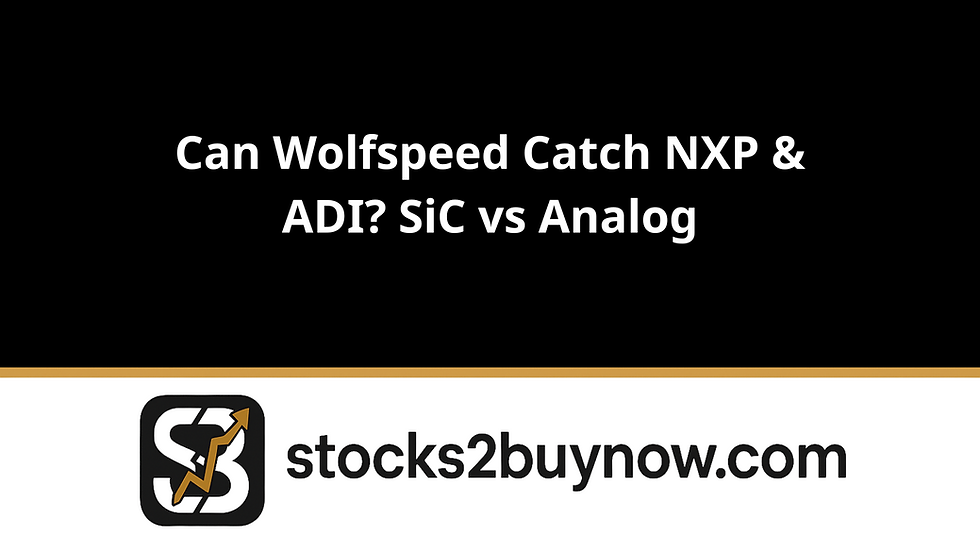NVDA vs AMD: Which Stock Is the Better Investment?
- Sanzhi Kobzhan

- Sep 22
- 6 min read
Updated: Sep 24

NVIDIA (NVDA) and Advanced Micro Devices (AMD) are two leading semiconductor stocks, and investors often ask “which stock is better, NVDA or AMD?” Both companies are market leaders in GPUs and AI processors, but their financial profiles differ markedly.
In this analysis, I’ll compare NVDA and AMD on key fundamentals – profitability, valuation, growth, and analyst outlook – to draw data-driven conclusions. I’ll also show how to use the Fundamental Analysis tool to automate this comparison. (All data are current as of late Sept 2025.)
Using the Fundamental Analysis Tool
My stock fundamental analysis tool lets you enter a ticker and your FMP API key, then fetches company data and computes ratios automatically. This app aggregates data from Financial Modeling Prep (FMP) APIs (real-time prices, financial statements, analyst estimates, etc.) to produce a comprehensive snapshot:
Company Overview – Sector, industry, business description.
Earnings History – Past and upcoming earnings dates, actual vs. estimated EPS and revenue.
Analyst Price Targets – Number of analyst estimates, minimum/average/maximum 12‑month targets.
Insider Trading Trends – Charts of insider buys vs. sells per quarter.
Valuation Metrics – Key ratios (P/E, PEG, EV/FCF, etc.) vs. sector averages.
Peer Comparison – A table of similar companies by market cap to see how each stacks up in size and price.
Key Efficiency Ratios – ROA, ROE, ROIC, cash flow yield, etc.
Profitability & Margins – Gross margin, net margin, OCF/Sales, etc.
Revenue Segmentation – Breakdown by business line (Data Center, Gaming, etc.).
Financial Growth – Year-over-year % growth of revenue, profit, cash flow, assets and liabilities. This highlights recent growth trends.
DCF Valuation – An estimated fair value via Discounted Cash Flow.
By entering “NVDA” or “AMD” into the app and pressing Analyze, investors instantly see all this data in one place. This saves hours of digging through SEC filings.
Key Metrics Comparison
Let’s start with a side-by-side snapshot of essential figures for NVDA and AMD (all trailing-12-month or latest values):
Metric | NVIDIA (NVDA) | AMD (Advanced Micro Devices) | Conclusion |
Stock Price (Sept 2025) | $175.88 | $161.42 | |
Market Cap | $4.28 trillion | $261.96 billion | Despite AMD’s growth, NVDA dominates in size. |
P/E (TTM) | 49.90 | 96.66 | NVIDIA looks cheaper on earnings |
Gross Profit Margin | 69.80 % | 44% | NVDA's gross profit margin reflecting premium pricing on GPUs. AMD’s gross margin is healthy but much lower. |
ROIC (Return on Invested Capital) | 70.7% | 4.3% | NVDA is vastly more efficient at turning invested capital into profit (70.7%) compared to AMD (4.3%). This underlines NVIDIA’s superior capital efficiency. |
Free Cash Flow Yield | 1.7% | 1.5% | oth companies show low yields (under 2%), suggesting investors are paying a high price for each unit of free cash flow. NVDA’s yield is slightly higher. |
Return on Equity (ROE) | 105.20 % | 4.9% | NVIDIA generates a ton of profit and cash from its revenues, whereas AMD’s returns on equity remain modest. |
EV / FCF (Enterprise Value / Free Cash Flow) | 59.41× | 64.64× | AMD’s multiple (64.64×) is higher than NVDA’s (59.25×), meaning AMD is more expensive relative to its free cash flow. |
OCF/Sales (Operating Cash Flow / Revenue) | 46.6% | 16.5% | NVDA converts nearly half its sales into operating cash flow (46.6%), while AMD only converts ~16.5%. This is a striking difference in cash generation strength. |
PEG Ratio (TTM) | 3.88 | 3.36 | AMD has a marginally lower PEG (3.36 vs 3.87), implying slightly better value relative to expected growth. However, both ratios are well above 1, showing neither is “cheap.” |
Data Center Rev (%) | ~88.3% of FY2025 revenue | ~48.8% of FY2024 revenue (AMD) | This numbers reflect NVIDIA’s leadership in AI/server GPUs. AMD’s revenue is more diversified |
Avg. 12M Price Target | $460.87 (analysts) | $148.29 (analysts) | According to consensus targets, analysts expect NVDA to continue rising. For NVDA, the average 12‑month price target is ~$460.87 vs current ~$176 (implying ~2.6× upside). For AMD, the average target is ~$148.29 vs ~$161 now, suggesting little upside and possibly a downgrade. |
DCF Fair Value | $136.99 (22% below current) | $60.90 (61% below current) | NVDA looks cheaper than AMD but both of them are overvalued based on the DCF price target. |
Financial Statements Growth | NVDA posted explosive growth in FY2025, with revenue, gross profit, operating income, net income and EPS up 114–147% yoy. (The app’s data shows ~114% revenue growth and ~145% net income growth). | AMD had robust but more modest growth. For FY2024, AMD’s revenue grew ~13.7%, net income ~92.2%, and EPS ~90.6%. | These reflect strong demand for NVIDIA’s products in AI and gaming. AMD benefits from new products, but its base is smaller. |
In summary, NVDA leads on scale, profitability, and growth prospects, whereas AMD trades at a higher valuation relative to its fundamentals.
Market Position & Industry Context
In the AI data center market, NVIDIA is the clear leader. Its GPUs dominate server AI workloads. AMD is catching up with new GPUs, but NVIDIA currently commands higher prices and performance.
AMD does have niches – its Ryzen CPUs and new data center chips – which have driven up its gross margin (AMD hit 53.7% gross margin in Q1 2025). Under Lisa Su’s leadership, AMD has steadily gained PC market share from Intel and is expanding in servers. The Bernstein downgrade note on AMD (July 2025) still acknowledged “growth opportunities remain” thanks to upcoming GPUs and CPUs.
For traders and investors, these differences matter.
Growth Investors will likely favor NVDA. Its financials show dominant profitability (ROE>100%) and accelerating sales. Analysts remain bullish, with many price targets well above the current share price. NVDA’s exposure to AI, gaming, and professional graphics suggests durable long-term growth.
Value Investors might look at AMD as a contrarian pick, but AMD’s high P/E and stretched valuation are risks. Some see AMD as “undervalued” only relative to its huge market potential; however, the fundamentals (much lower margins and returns) imply that AMD must execute strongly to justify its price. The fundamental analysis shows AMD with a premium valuation despite solid recent growth.
Ultimately, NVDA appears stronger on key fundamentals. Its unmatched profitability (69.80% gross margin) and high returns make it a favorite for long-term portfolios. AMD is not “bad” – it just isn’t outperforming NVIDIA in these metrics.
Why This Tool Helps Investors and Traders
The Fundamental Analysis tool is useful because it automatically condenses a company’s key data into one view, making comparisons easy. Instead of manually gathering earnings dates, analyst ratings, insider trades, financial ratios, and news, an investor can see them together.
This speeds up decisions: for example, if you’re deciding between NVDA and AMD, you immediately see NVDA’s higher ROE and profit margin and lower P/E in one glance, informing your choice.
NVDA vs AMD from the fundamental standpoint.
When comparing NVDA and AMD across profitability, efficiency, growth, and valuation, NVIDIA emerges as the stronger fundamental choice:
NVDA outperforms dramatically on ROIC, ROE, gross margin, and OCF/Sales, proving it extracts far more value from capital and sales.
While both appear expensive on a DCF basis, AMD trades at higher P/E and EV/FCF multiples, making it relatively more overvalued.
Analysts project significantly more upside for NVDA (average price target ~$460 vs ~$176 current), while AMD’s target is actually below its current price.
The only modest edge for AMD is a slightly lower PEG ratio, but this doesn’t outweigh NVIDIA’s clear leadership in profitability and growth.
For long-term investors seeking exposure to the AI and semiconductor boom, NVDA’s superior efficiency and profitability metrics make it the better pick. AMD remains a strong competitor with diversified revenue streams, but at current valuations, its fundamentals lag NVIDIA’s by a wide margin.
AMD or NVIDIA? Fundamentals Decide
Frequently Asked Questions
Which is a better stock right now: NVIDIA (NVDA) or AMD?
NVIDIA has stronger fundamentals: much higher profit margins and returns on equity, plus solid growth in AI. AMD has grown but trades at a much higher P/E and lower profitability. Based on recent financials, NVDA looks stronger. (However, if one expects a turnaround or values AMD’s diversification, AMD might appeal.) Always consider your investment goals and time horizon.
How do NVDA and AMD compare in growth?
NVDA’s revenue and earnings grew triple-digit percentages in the past year due to AI demand. AMD also grew revenue (double-digit growth) but from a smaller base. In short-term catalysts (like new chips), AMD can jump, but NVIDIA’s overall growth rate has been much higher.
Why is NVIDIA’s ROE so high?
ROE (Return on Equity) = Net Income / Equity. NVIDIA’s ROE (~105%) is unusually high because the company has very high net margins and has kept shareholder equity relatively modest (it often repurchases shares). This means NVIDIA generates over $1 of profit for every $1 of equity, an indicator of enormous profitability. AMD’s ROE (~4.9%) is normal for tech hardware companies and reflects its more moderate profits.
What are current analyst price targets for NVDA and AMD?
The app data above list NVDA’s 12-month price targets (min $90, avg $460.87, max $1,400) and AMD’s (min $65, avg $148.29, max $345). These are consensus forecasts aggregated from broker reports. Note how NVDA’s average target (~$461) is far above its price, while AMD’s average (~$148) is below its current price, indicating analysts are more bullish on NVDA.
How often should I update the analysis?
You can re-run the tool anytime, as it fetches live data. For critical data (like quarterly financials), update after each earnings release. The advantage of the tool is you simply hit “Analyze” and get fresh numbers.





Comments